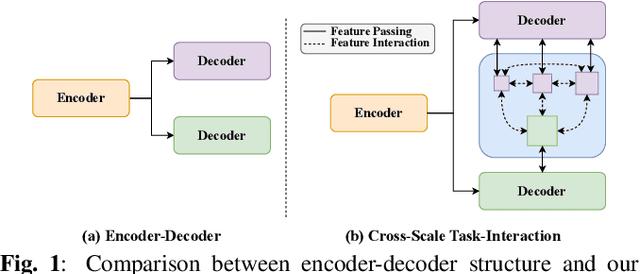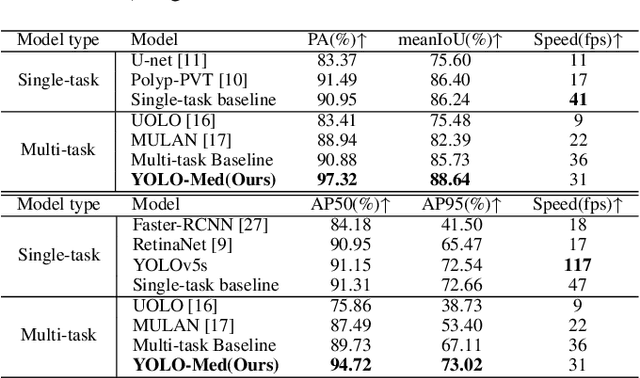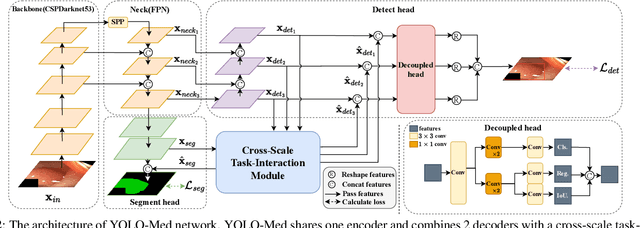Yuxiang Lu
MORE: Multi-Organ Medical Image REconstruction Dataset
Oct 30, 2025Abstract:CT reconstruction provides radiologists with images for diagnosis and treatment, yet current deep learning methods are typically limited to specific anatomies and datasets, hindering generalization ability to unseen anatomies and lesions. To address this, we introduce the Multi-Organ medical image REconstruction (MORE) dataset, comprising CT scans across 9 diverse anatomies with 15 lesion types. This dataset serves two key purposes: (1) enabling robust training of deep learning models on extensive, heterogeneous data, and (2) facilitating rigorous evaluation of model generalization for CT reconstruction. We further establish a strong baseline solution that outperforms prior approaches under these challenging conditions. Our results demonstrate that: (1) a comprehensive dataset helps improve the generalization capability of models, and (2) optimization-based methods offer enhanced robustness for unseen anatomies. The MORE dataset is freely accessible under CC-BY-NC 4.0 at our project page https://more-med.github.io/
Is Diversity All You Need for Scalable Robotic Manipulation?
Jul 08, 2025Abstract:Data scaling has driven remarkable success in foundation models for Natural Language Processing (NLP) and Computer Vision (CV), yet the principles of effective data scaling in robotic manipulation remain insufficiently understood. In this work, we investigate the nuanced role of data diversity in robot learning by examining three critical dimensions-task (what to do), embodiment (which robot to use), and expert (who demonstrates)-challenging the conventional intuition of "more diverse is better". Throughout extensive experiments on various robot platforms, we reveal that (1) task diversity proves more critical than per-task demonstration quantity, benefiting transfer from diverse pre-training tasks to novel downstream scenarios; (2) multi-embodiment pre-training data is optional for cross-embodiment transfer-models trained on high-quality single-embodiment data can efficiently transfer to different platforms, showing more desirable scaling property during fine-tuning than multi-embodiment pre-trained models; and (3) expert diversity, arising from individual operational preferences and stochastic variations in human demonstrations, can be confounding to policy learning, with velocity multimodality emerging as a key contributing factor. Based on this insight, we propose a distribution debiasing method to mitigate velocity ambiguity, the yielding GO-1-Pro achieves substantial performance gains of 15%, equivalent to using 2.5 times pre-training data. Collectively, these findings provide new perspectives and offer practical guidance on how to scale robotic manipulation datasets effectively.
BECAME: BayEsian Continual Learning with Adaptive Model MErging
Apr 03, 2025Abstract:Continual Learning (CL) strives to learn incrementally across tasks while mitigating catastrophic forgetting. A key challenge in CL is balancing stability (retaining prior knowledge) and plasticity (learning new tasks). While representative gradient projection methods ensure stability, they often limit plasticity. Model merging techniques offer promising solutions, but prior methods typically rely on empirical assumptions and carefully selected hyperparameters. In this paper, we explore the potential of model merging to enhance the stability-plasticity trade-off, providing theoretical insights that underscore its benefits. Specifically, we reformulate the merging mechanism using Bayesian continual learning principles and derive a closed-form solution for the optimal merging coefficient that adapts to the diverse characteristics of tasks. To validate our approach, we introduce a two-stage framework named BECAME, which synergizes the expertise of gradient projection and adaptive merging. Extensive experiments show that our approach outperforms state-of-the-art CL methods and existing merging strategies.
AgiBot World Colosseo: A Large-scale Manipulation Platform for Scalable and Intelligent Embodied Systems
Mar 09, 2025Abstract:We explore how scalable robot data can address real-world challenges for generalized robotic manipulation. Introducing AgiBot World, a large-scale platform comprising over 1 million trajectories across 217 tasks in five deployment scenarios, we achieve an order-of-magnitude increase in data scale compared to existing datasets. Accelerated by a standardized collection pipeline with human-in-the-loop verification, AgiBot World guarantees high-quality and diverse data distribution. It is extensible from grippers to dexterous hands and visuo-tactile sensors for fine-grained skill acquisition. Building on top of data, we introduce Genie Operator-1 (GO-1), a novel generalist policy that leverages latent action representations to maximize data utilization, demonstrating predictable performance scaling with increased data volume. Policies pre-trained on our dataset achieve an average performance improvement of 30% over those trained on Open X-Embodiment, both in in-domain and out-of-distribution scenarios. GO-1 exhibits exceptional capability in real-world dexterous and long-horizon tasks, achieving over 60% success rate on complex tasks and outperforming prior RDT approach by 32%. By open-sourcing the dataset, tools, and models, we aim to democratize access to large-scale, high-quality robot data, advancing the pursuit of scalable and general-purpose intelligence.
Topology-Aware Popularity Debiasing via Simplicial Complexes
Nov 21, 2024Abstract:Recommender systems (RS) play a critical role in delivering personalized content across various online platforms, leveraging collaborative filtering (CF) as a key technique to generate recommendations based on users' historical interaction data. Recent advancements in CF have been driven by the adoption of Graph Neural Networks (GNNs), which model user-item interactions as bipartite graphs, enabling the capture of high-order collaborative signals. Despite their success, GNN-based methods face significant challenges due to the inherent popularity bias in the user-item interaction graph's topology, leading to skewed recommendations that favor popular items over less-known ones. To address this challenge, we propose a novel topology-aware popularity debiasing framework, Test-time Simplicial Propagation (TSP), which incorporates simplicial complexes (SCs) to enhance the expressiveness of GNNs. Unlike traditional methods that focus on pairwise relationships, our approach captures multi-order relationships through SCs, providing a more comprehensive representation of user-item interactions. By enriching the neighborhoods of tail items and leveraging SCs for feature smoothing, TSP enables the propagation of multi-order collaborative signals and effectively mitigates biased propagation. Our TSP module is designed as a plug-and-play solution, allowing for seamless integration into pre-trained GNN-based models without the need for fine-tuning additional parameters. Extensive experiments on five real-world datasets demonstrate the superior performance of our method, particularly in long-tail recommendation tasks. Visualization results further confirm that TSP produces more uniform distributions of item representations, leading to fairer and more accurate recommendations.
Differentiable Gaussian Representation for Incomplete CT Reconstruction
Nov 07, 2024Abstract:Incomplete Computed Tomography (CT) benefits patients by reducing radiation exposure. However, reconstructing high-fidelity images from limited views or angles remains challenging due to the ill-posed nature of the problem. Deep Learning Reconstruction (DLR) methods have shown promise in enhancing image quality, but the paradox between training data diversity and high generalization ability remains unsolved. In this paper, we propose a novel Gaussian Representation for Incomplete CT Reconstruction (GRCT) without the usage of any neural networks or full-dose CT data. Specifically, we model the 3D volume as a set of learnable Gaussians, which are optimized directly from the incomplete sinogram. Our method can be applied to multiple views and angles without changing the architecture. Additionally, we propose a differentiable Fast CT Reconstruction method for efficient clinical usage. Extensive experiments on multiple datasets and settings demonstrate significant improvements in reconstruction quality metrics and high efficiency. We plan to release our code as open-source.
Swiss Army Knife: Synergizing Biases in Knowledge from Vision Foundation Models for Multi-Task Learning
Oct 18, 2024Abstract:Vision Foundation Models (VFMs) have demonstrated outstanding performance on numerous downstream tasks. However, due to their inherent representation biases originating from different training paradigms, VFMs exhibit advantages and disadvantages across distinct vision tasks. Although amalgamating the strengths of multiple VFMs for downstream tasks is an intuitive strategy, effectively exploiting these biases remains a significant challenge. In this paper, we propose a novel and versatile "Swiss Army Knife" (SAK) solution, which adaptively distills knowledge from a committee of VFMs to enhance multi-task learning. Unlike existing methods that use a single backbone for knowledge transfer, our approach preserves the unique representation bias of each teacher by collaborating the lightweight Teacher-Specific Adapter Path modules with the Teacher-Agnostic Stem. Through dynamic selection and combination of representations with Mixture-of-Representations Routers, our SAK is capable of synergizing the complementary strengths of multiple VFMs. Extensive experiments show that our SAK remarkably outperforms prior state of the arts in multi-task learning by 10% on the NYUD-v2 benchmark, while also providing a flexible and robust framework that can readily accommodate more advanced model designs.
Learning Multiple Representations with Inconsistency-Guided Detail Regularization for Mask-Guided Matting
Mar 28, 2024Abstract:Mask-guided matting networks have achieved significant improvements and have shown great potential in practical applications in recent years. However, simply learning matting representation from synthetic and lack-of-real-world-diversity matting data, these approaches tend to overfit low-level details in wrong regions, lack generalization to objects with complex structures and real-world scenes such as shadows, as well as suffer from interference of background lines or textures. To address these challenges, in this paper, we propose a novel auxiliary learning framework for mask-guided matting models, incorporating three auxiliary tasks: semantic segmentation, edge detection, and background line detection besides matting, to learn different and effective representations from different types of data and annotations. Our framework and model introduce the following key aspects: (1) to learn real-world adaptive semantic representation for objects with diverse and complex structures under real-world scenes, we introduce extra semantic segmentation and edge detection tasks on more diverse real-world data with segmentation annotations; (2) to avoid overfitting on low-level details, we propose a module to utilize the inconsistency between learned segmentation and matting representations to regularize detail refinement; (3) we propose a novel background line detection task into our auxiliary learning framework, to suppress interference of background lines or textures. In addition, we propose a high-quality matting benchmark, Plant-Mat, to evaluate matting methods on complex structures. Extensively quantitative and qualitative results show that our approach outperforms state-of-the-art mask-guided methods.
Task Indicating Transformer for Task-conditional Dense Predictions
Mar 01, 2024



Abstract:The task-conditional model is a distinctive stream for efficient multi-task learning. Existing works encounter a critical limitation in learning task-agnostic and task-specific representations, primarily due to shortcomings in global context modeling arising from CNN-based architectures, as well as a deficiency in multi-scale feature interaction within the decoder. In this paper, we introduce a novel task-conditional framework called Task Indicating Transformer (TIT) to tackle this challenge. Our approach designs a Mix Task Adapter module within the transformer block, which incorporates a Task Indicating Matrix through matrix decomposition, thereby enhancing long-range dependency modeling and parameter-efficient feature adaptation by capturing intra- and inter-task features. Moreover, we propose a Task Gate Decoder module that harnesses a Task Indicating Vector and gating mechanism to facilitate adaptive multi-scale feature refinement guided by task embeddings. Experiments on two public multi-task dense prediction benchmarks, NYUD-v2 and PASCAL-Context, demonstrate that our approach surpasses state-of-the-art task-conditional methods.
YOLO-MED : Multi-Task Interaction Network for Biomedical Images
Mar 01, 2024



Abstract:Object detection and semantic segmentation are pivotal components in biomedical image analysis. Current single-task networks exhibit promising outcomes in both detection and segmentation tasks. Multi-task networks have gained prominence due to their capability to simultaneously tackle segmentation and detection tasks, while also accelerating the segmentation inference. Nevertheless, recent multi-task networks confront distinct limitations such as the difficulty in striking a balance between accuracy and inference speed. Additionally, they often overlook the integration of cross-scale features, which is especially important for biomedical image analysis. In this study, we propose an efficient end-to-end multi-task network capable of concurrently performing object detection and semantic segmentation called YOLO-Med. Our model employs a backbone and a neck for multi-scale feature extraction, complemented by the inclusion of two task-specific decoders. A cross-scale task-interaction module is employed in order to facilitate information fusion between various tasks. Our model exhibits promising results in balancing accuracy and speed when evaluated on the Kvasir-seg dataset and a private biomedical image dataset.
 Add to Chrome
Add to Chrome Add to Firefox
Add to Firefox Add to Edge
Add to Edge